| Article ID | Journal | Published Year | Pages | File Type |
|---|---|---|---|---|
| 8786498 | Clinical Radiology | 2018 | 7 Pages |
Abstract
Screening with mammography has been implemented in many countries across the world with most offering 2-yearly examinations between the ages of 50-69 years. Robust modelling tools that include breast density and single nucleotide polymorphisms (SNPs) have been developed to predict which women are most likely to develop breast cancer. Mammographic sensitivity is poor in women with the densest category of breast tissue, and even women with heterogeneously dense tissue may benefit from additional supplemental imaging. Digital breast tomosynthesis (DBT), automated breast ultrasound (ABUS), contrast-enhanced mammography (CESM) or abbreviated (ABB) magnetic resonance imaging (MRI) all offer the opportunity to increase cancer detection, especially in women with dense breasts at increased risk of cancer. DBT increases cancer detection by around 15% with a corresponding reduction in recall rates; ABUS has been shown to increase cancer detection by between 2-4/1,000 depending on the cohort being examined and results in increased recalls, which tend to fall in subsequent screening rounds; CESM has very high sensitivity almost matching MRI with slightly improved specificity; ABB-MRI has been shown to be virtually equivalent to standard protocol MRI examinations, making this a technique that could be considered as a screening tool in high-risk women. This article reviews the literature to establish the current status of these techniques. The cost-effectiveness of these techniques requires further investigation and screening trials should report the nature of any additional tumours that are found.
Related Topics
Health Sciences
Medicine and Dentistry
Oncology
Authors
F.J. Gilbert, A. Selamoglu,
